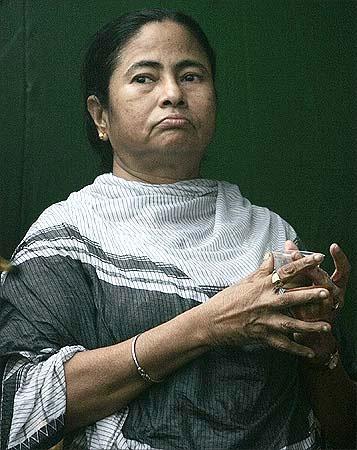
The railway minister's indifference to her portfolio, the hesitation to install anti-collision devices that cost Rs 250,000 per km and the debate over the efficiency of home-grown technology are leading to more accidents.
In the Railway Budget speech on February 24, 2010, Railway Minister Mamata Banerjee stressed the need to install cutting-edge equipment to prevent train accidents.
Vision 2020, the ministry's statement of intent, aims at making railway operations free of accidents, be it derailment, collision or fire on trains.
"The ACD (anti-collision device) and TPWS (train protection warning systems) are two such devices. The former has already been installed on the North Frontier Railway (NFR) and is now proposed to be extended to three more zonal railways. Four projects of TPWS covering 828 route kilometres for improving safety and preventing collision accidents will be implemented during the year," Mamata had said in Parliament.
Mamata promised the Parliament of 'zero tolerance to accidents'. But senior railway officials say that the project of extending use of safety tools in different zones has yet to take off.
Current implementation status
After installing the ACDs over the 1,736-km route of NFR, the railway minister said that the remaining 1,700 km more of NFR will be covered, but financial issues are holding that up. The NFR expressed the intent to install this system across its network but the Rail Bhavan has since then framed revised specifications.
The KRCL (Konkan Railway Corporation Ltd) was told to improve the system as per the revised specifications before it could be extended to the 1,600-km route of the Southern, South Central and South Western Railways.
. . .
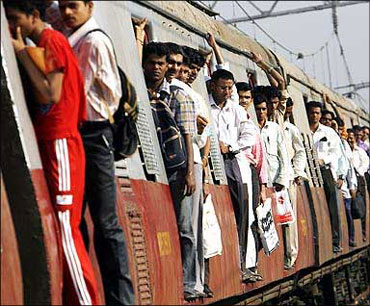
The matter has been stuck for months now. Sources said the KRCL told the railway ministry that it would not be able to install the ACD until its NFR dues of about Rs 40 crore (Rs 400 million) were cleared.
While the ministry revised the specifications for the product, the KRCL, sources said, sought fixed parameters for commissioning the project. Mamata Banerjee's repeated absence from New Delhi has not helped matters.
Rajaram's letter to railway ministry
Former Konkan Railway managing director B Rajaram raised the issue of implementation of ACDs with Banerjee in a letter written on April 5 this year, drawing her attention to the money earmarked for the Research Design and Standards Organisation, the ministry's apex research body.
Rajaram said: "Its implementation is being delayed over the years by successive revision of norms by the Railway Board even though the technology meets the conditions successfully in every instance."
He said that "Indian Railways has not produced any world-class technology since Independence. We spend so much of funds on RDSO, but we have nothing innovative or world-class to get from RDSO or even to be used by Indian Railways. We just import. RDSO is used to assist while importing."
The letter said the device named 'Raksha Kavach' was developed indigenously and was even singled out from the millions of global patents and praised as a unique safety system by the World Intellectual Property Office (WIPO) in Geneva.
. . .
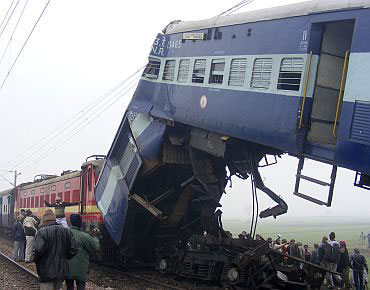
"But the multinational companies, which have much to lose if ACD comes in operation, have consistently been fighting a proxy technology war using our own retired and even working railway officers."
He went on to add that at every stage of development, hurdles were raised and even its implementation in the Northeast Frontier Railway would have been blocked but for former railway minister and current Bihar Chief Minister Nitish Kumar.
Rajaram said: "The ACDs fill up gaps of what existing systems cannot do, like averting collisions, even in block sections (the distance between two stations beyond the range of signals) and in foggy weather when signals are not visible."
Experts' view
Prakash Mandoth, an expert with the railways and an ex-member of the Zonal Railways Users Consultative Committee, South Western Railways, says that it is surprising that the ACD, despite being proposed so long back, has not been implemented fully as yet.
The ACD, the patent of the Konkan Railways, is the ideal solution to railway safety. However, the implementation of the ACD is being delayed over the years and this is due to the changing norms of the Railways Board, says Mandoth.
Mandoth says such accidents could have been clearly avoided had there been such a device in place. The irony, however, is that despite the Railway Board assuring that this would be implemented by 2009 in a phased manner, the device has yet to see the light of day.
. . .
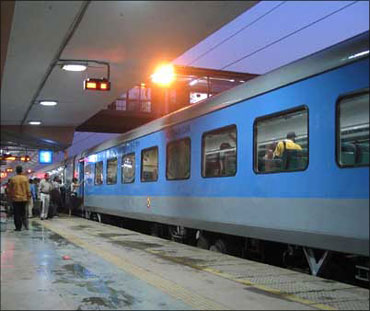
Mandoth said, "I would not be in a position to comment on why it has not been implemented as yet. This has been time-tested and has proven to work effectively. The board should bear in mind that people travelling on a train do so with a lot of trust. Moreover, it is considered safer than air travel. When the public has laid its trust on the railways, it is not right for them to play with people's lives. The railways have a lot to answer, since they have not used technology when it has been readily provided to them."
Other experts say that the recent collision between the Uttarbanga Express and Vananchal Express may have been averted had a system like the ACDs been installed on the Bardhaman-Rampurhat section of the Howrah division.
Waking up from deep slumber
It was only after the recent accident in West Bengal, that the decision to install ACDs was taken at a high-level meeting of railway officials. According to a Railway Board official, the ACDs have been successfully tested by the railway's research wing at Lucknow.
The Board official told the media that the delay in installing ACD is due to the fact that the railways intend to slightly modify the design and structure of the newly created device.
Installation of ACDs is bound to check collisions in block sections and bring the accident rate to zero level, particularly on long routes and accident-prone sections.
The railway officials claim to have ordered faster work on improving current ACDs and said they are prepared to look abroad for tried-and-tested devices. Railway Board chairman Vivek Sahai told the media recently, "After five major accidents this year, we will not wait any more. We are ready to import devices but they have to pass tough Indian tests."
. . .

The Railway Board had decided to manufacture such foolproof devices when about 200 passengers were killed near Khanna station on November 26, 1998 when the Jammu-Tawi Sealdah Express collided head-on with Amritsar-bound Frontier Golden Temple Mail. Since then, a series of train accidents, particularly head-on collisions, took place across the country killing hundreds of passengers.
Had this project been implemented on a priority basis, many precious lives could have been saved, sources said, adding that the ACD is the only device to check head-on collisions caused by human error.
Problem with ACDs
However, following the Sainthia train collision which claimed 60 lives and injured 150 people in West Bengal, railway officials suddenly said that they have encountered operational problems with the ACDs in operation.
They claim that the resolution of Global Positioning System (GPS) is not precise enough at small separations between parallel tracks. At times, it fails to detect trains on the same track or confuses up-down movement on the parallel lines. It also needs extensive support of devices that are installed on the ground along the line.
Railway officials said that efforts and research to improve the ACDs are underway. It is also fairly expensive, though the cost of Rs 250,000 per km must be judged in terms of lives saved.
The Railway Board chairman said the railways cannot commit to such a large investment if the system is not precise, though he conceded that ACDs are needed.
. . .
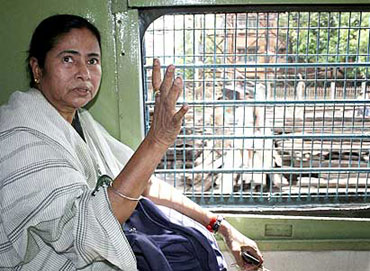
Anil Saxena, ADG, Railway Board, says: "The Konkan authorities have been asked to make specific changes in the system. They are yet to report to the Railway Board. Once the board approves the new technology, three zones -- South, South-West and South-Central will implement it."
Rajaram's counter arguments
Refuting the statements of the railway officials, Rajaram said that the ACD had the support of Railway Minister Mamata Banerjee in her earlier stint at the Rail Bhavan in New Delhi.
Speaking from his residence in Herndon in Vermont in the US, Rajaram said: "During her stint as railway minister in 1999, Mamata Banerjee herself had encouraged me to develop the system. She had even briefed Parliament about its effectiveness."
He said that this technology had been ready for use since 2003.
Rajaram added: "An ACD could have easily avoided this accident by stopping the moving train before it hit the train that was pulling out of the station."
According to him, the ACD intelligent network covering locomotives, the last coach, stations and level crossings was capable of stopping a train or trains without human interference to avert a collision. The use of such devices is an integral part of any modern railway system. The Japanese and the US railway networks have minimised human error with the use of such technology.
. . .

When informed about the Railway Board's reservations about the ACDs, Rajaram, who has donated the ACD patent to the railways, said: "The Railway Board had certified it earlier. . . Even Lloyds, UK, had certified it on the basis of its performance on the North Frontier Railway. I don't know why the chairman of the Railway Board made such observations."
G Raghuram, the Indian Railways chair professor at IIM Ahmedabad, too endorsed the use of ACDs. The devices constantly monitor moving units using radio transceivers, software, and positioning systems within a radius of twice the braking distance required and automatically get activated to prevent a collision.
With some Japanese and US companies pitching for the contract, competition has intensified for the home-grown ACD.
Still in 1940s? Urgent reforms needed
Experts argue that outdated communication, safety and signalling equipment, currently being used, contribute to failures in the system. There is an urgent need for upgrading this with the latest technology. It is felt that this would be required given the gradual increase in train speeds and lengths.
No funds for safety and modernisation?
The government often says that the lack of funds is a major constraint for safety and security of the railway networks in India. However, experts feel that safety projects are hampered by diversion of funds meant for infrastructure to other purposes due to various political compulsions.
In the name of modernisation, the ministry of railways in 2001 created a non-lapsable safety fund of Rs 17,000 crore (Rs 170 billion) exclusively for the renewal of overage tracks, bridges, rolling stock and signalling gear. In 2003, the ministry also prepared a Corporate Safety Plan for the next ten years with the objective of realising a vision of an accident-free and casualty-free railway system.
. . .

The plan, with an outlay of Rs 31,835 crore (Rs 318.35 billion), also envisaged development of appropriate technology for higher level of safety in train operation.
Now, however, it is clear that the above quoted budget plan was not really fully allocated.
Does Mamata have some mamata for rail safety?
On the recent increase of rail accidents, it is clear that the whole system -- from the top to the safety inspection personnel -- appears to be disinterested in railway safety procedures. In such a scenario, the one person who has to be held responsible is the railway minister.
But one may ask why single out Mamata? Well, in the 14 months during which Mamata Banerjee has been at the helm of the Railway ministry, as many as 428 people have been killed and over 600 injured in some 200 train accidents.
The sharp rise in the number of rail accidents ever since she assumed charge as minister of railways has strengthened the criticism that she is not too interested in her portfolio and prefers to devote more time to poll-bound West Bengal where she hopes to dislodge the Left Front from power next year.
Senior officials in the railway ministry, speaking on the condition of anonymity, admit that the minister's attitude towards her work appears to be trickling down to the junior-most levels.
"There appears to be no sense of direction, no focus. Over the past few years, accidents had reduced considerably. The Railways needed to build on that. But we again appear to be headed towards the period when rail accidents were frequent," said a senior official. It is necessary that people working in public life should set up a good example for their subordinates.
. . .

Mamata's absence from Rail Bhavan ensures that files needing her signatures keep piling up. One such important decision relates to the filling of some 90,000 safety-related posts. Vacancies in posts of gangmen, pointsmen, signalmen and assistant station masters are also in the way of smooth running of safety systems.
In the past, Mamata had also been criticised for not visiting sites of serious rail accidents. Her PR machinery then claimed she deliberately stayed away, saying that her presence could have affected rescue and relief operations.
But when it comes to West Bengal, her home state, she seems to have a different take. Hours after the news of the collision between the Vananchal Express and Uttarbanga Express, Banerjee flew from Delhi to Kolkata and travelled to the accident site. In May 2010, too, she visited the site of the Jnaneshwari Express derailment which claimed 148 lives.
The journey ahead
The bitter truth is that train accidents such as derailment and collisions are more common in recent times. Indian Railways has accepted the fact that given the size of its operations, eliminating accidents is an unrealistic goal, and at best they can only minimise the accident rate.
Human error is the primary cause leading to 83% of all train accidents in India. While accident rates are low -- 0.55 accidents per million train kilometre -- the absolute number of people killed is high because of the large number of people making use of the network.
While strengthening and modernisation of railway infrastructure is in progress, much of the network still uses old signalling and has antiquated bridges.
. . .
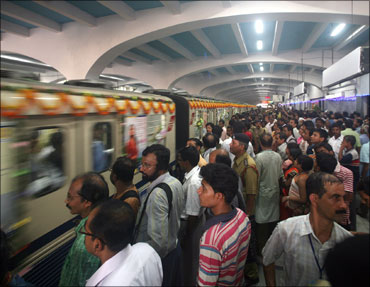
On injecting technology for rail safety, Banerjee made all the right noises in her Rail Budget speech but did little to ensure that a life saving system like ACD is given top priority.
On the implementation of ACDs, on the one side the railway officials say that it is not fit to be implemented due to financial and technical issues but on the other side they say the ACDs are to be implemented with immediate effect.
Shockingly the 10-year-old project of Raksha Kavach (ACD) is still undergoing technical evaluation even as accidents continue to rise. With outdated techniques of dealing with railway safety, the lifeline of the country is surely in God's hands.
So the next time before we board the train, all of us should have a silent prayer on our lips!
The author is an Independent Researcher, specializing in Systems Security.